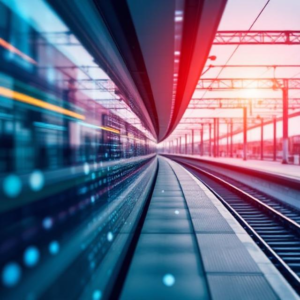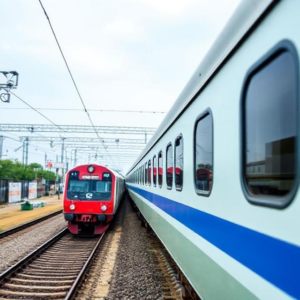1. What is Railway Data Analytics?
Railway Data Analytics is the process of collecting and analyzing data to improve the performance, safety, and efficiency of the railway system.
Imagine a railway system like a giant puzzle where everything needs to fit together perfectly—trains, tracks, stations, signals, etc. By using data analytics, rail companies can get a clearer picture of how the entire system is working and find ways to improve it.
Key Areas Where Data Analytics is Used in Railways:
- Predictive Maintenance: Identifying when equipment (like trains or tracks) might break down before it happens. This allows for repairs to be scheduled in advance, reducing delays and increasing safety.
- Traffic Management: Ensuring that trains run smoothly without delays by optimizing routes and schedules based on real-time data.
- Energy Efficiency: Analyzing energy use to reduce costs and make trains more eco-friendly.
- Customer Experience: Using data to understand passenger behavior, improve services, and predict demand (e.g., how many passengers will travel on a specific route).

2. What is Big Data in Railways?
Big Data refers to the enormous amounts of information that are generated by railway systems and operations every day. These datasets are too large and too complex to be processed by traditional data tools and methods. However, with the right technologies, this data can be used to make better decisions and improve railway services.
Some examples of the kind of data involved in Big Data for railways include:
- Train movements (speed, location, and schedules).
- Track conditions (e.g., if a track is damaged or needs maintenance).
- Passenger data (how many people are on a train, when they get on or off, etc.).
- Weather data (how rain, snow, or heat affects trains and tracks).
- Operational data (fuel usage, train performance, etc.).
3. How Does Railway Data Analytics and Big Data Work?
a) Data Collection
Railways generate massive amounts of data from sensors, devices, GPS, ticketing systems, and more. For example:
- GPS sensors on trains track their speed and location.
- Trackside sensors monitor the condition of the tracks.
- Passenger information systems track when and where people board and exit trains.
All this data is collected constantly—in real-time as trains are operating.
b) Data Storage
The huge amount of data collected has to be stored somewhere. Railways use data storage systems (like cloud storage or data centers) to store all this information in a way that it can be easily accessed and analyzed later.
c) Data Analysis
Once the data is collected and stored, data analytics tools are used to analyze it. These tools can:
- Look for patterns or trends (e.g., when most passengers are traveling).
- Predict potential problems (like when a train might break down or if a track needs repairs).
- Make decisions (e.g., adjusting train schedules based on weather conditions).
The analysis can be done using different types of technologies, like:
- Machine Learning: A type of artificial intelligence (AI) that can predict future events by learning from historical data.
- Data Visualization: Turning data into charts, graphs, or maps to make it easier to understand and act on.
d) Real-time Decision Making
Using the data analysis, real-time decisions can be made. For example:
- If there’s a lot of traffic on one track, the system can suggest rerouting other trains to avoid delays.
- If a sensor detects a problem with a train or track, the system can automatically alert maintenance teams, and repairs can be scheduled.
- Based on weather data, trains might slow down in snowy conditions or reroute if there are floods.
4. Benefits of Data Analytics and Big Data in Railways
Here’s how data analytics and Big Data can help improve railways:
a) Improved Safety
- By analyzing data from sensors on trains and tracks, railway companies can detect early signs of problems like mechanical failures or track defects. This allows for preventative maintenance, which reduces accidents and derailments.
b) Better Train Scheduling and Traffic Management
- Data analytics helps to optimize train schedules by understanding patterns, like how many passengers use a specific route at different times. This helps to reduce delays and ensure trains are running on time.
- Traffic management systems can ensure that trains don’t get stuck waiting for each other on the tracks. By analyzing data, systems can direct trains to alternate tracks or adjust speeds to avoid bottlenecks.
c) Cost Savings
- By using data to predict when equipment will fail, maintenance can be scheduled at the right time—avoiding expensive emergency repairs.
- Analyzing fuel usage can help identify more efficient routes for trains, reducing energy costs.
d) Improved Passenger Experience
- Rail companies can predict demand by analyzing data about passenger numbers. If a particular route gets crowded at certain times, they can adjust the train frequency or add more cars to ensure comfortable travel for passengers.
- Real-time information about train delays, availability, and track conditions can be shared with passengers, improving customer satisfaction.
e) Environmental Benefits
- Data can help train operators identify ways to reduce fuel consumption and carbon emissions. For example, by optimizing speed and train routes, energy efficiency can be improved, making the system more eco-friendly.
5. Examples of How Data Analytics and Big Data Are Used in Railways
Here are a few real-life examples:
a) Predictive Maintenance
- Trains are equipped with sensors that collect data about things like the condition of wheels, brakes, and engines. By analyzing this data, railway companies can predict when parts are likely to fail and repair them before they break. For example, if the system detects that a train’s brakes are wearing out, maintenance crews are notified to check the brakes before they fail.
b) Smart Train Scheduling
- In cities with heavy rail traffic, data analytics is used to optimize train schedules. For example, if the system detects that a certain line is getting crowded during rush hour, it can automatically increase the frequency of trains or adjust the train sizes to accommodate more passengers.
c) Weather and Track Condition Monitoring
- Railways collect data on weather conditions, like rain or snow, and analyze how these affect the tracks. If heavy rain is expected, the system can slow down trains to prevent accidents. It can also monitor track conditions to detect rail degradation or damage that may occur after extreme weather.
d) Dynamic Pricing and Passenger Demand Forecasting
- By analyzing passenger data, rail companies can forecast demand for different routes and times. They can then offer dynamic pricing, where ticket prices change based on demand. For example, tickets may be cheaper for off-peak times and more expensive during rush hour.
6. Challenges of Using Data Analytics and Big Data in Railways
While these technologies offer huge benefits, there are some challenges:
- Data Privacy and Security: Protecting passenger data and ensuring it is used ethically is important.
- Data Overload: Railways collect so much data that it can be hard to manage and analyze it all. Effective data management tools are needed to make sense of it.
- Integration with Older Systems: Older railway systems may not be able to easily handle new data analytics technologies, requiring expensive upgrades.
7. Conclusion
Railway Data Analytics and Big Data are powerful tools for improving the safety, efficiency, and overall performance of train systems. By collecting and analyzing data from various sources like sensors, GPS, and passenger information, railways can make better decisions, prevent accidents, optimize train schedules, reduce costs, and improve the passenger experience. Even though there are challenges, the potential of using data to improve railways is huge and has already begun transforming the industry.
If you have any more questions or want more details, feel free to ask!
Keywords: Railway Data Analytics, Railway










